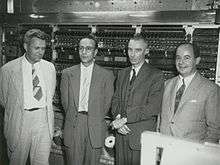Julian Bigelow
Julian Bigelow (March 19, 1913 – February 17, 2003) was a pioneering American computer engineer.

Life
Bigelow was born in 1913 in Nutley, New Jersey.[1] He obtained a master's degree at the Massachusetts Institute of Technology, studying electrical engineering and mathematics. During World War II, he assisted Norbert Wiener in his research on automated fire control for anti-aircraft guns, leading to the development of the so-called Wiener filter.
Bigelow coauthored (with Wiener and Arturo Rosenblueth) one of the founding papers on cybernetics and modern teleology, titled "Behavior, Purpose and Teleology." This paper mulled over the way mechanical, biological, and electronic systems could communicate and interact. This paper instigated the formation of the Teleological Society and later the Macy conferences. Bigelow was an active member of both organizations. He was a visiting scholar for many years at the Institute for Advanced Study in Princeton.[2]
When John von Neumann sought to build one of the very first digital computers at the Institute for Advanced Study, he hired Bigelow in 1946 as his "engineer," on Wiener's recommendation. The computer Bigelow built following von Neumann's design is called the IAS machine, although it was also called the MANIAC, a name that was later transferred to the successful clone of this machine at Los Alamos. Because von Neumann did not patent the IAS and wrote about it freely, 15 clones of the IAS were soon built. Nearly all general-purpose computers subsequently built are recognizable as influenced by the IAS machine's design.
Bigelow died on February 17, 2003 in Princeton, New Jersey.[3]
References
- ↑ Staff. A COMMUNITY OF SCHOLARS: The Institute for Advanced Study Faculty and Members 1930-1980, p. 58. Institute for Advanced Study, 1980. Accessed November 20, 2015. "Bigelow, Julian Himely NS, Computer Science, Applied Mathematics Born 1913 Nutley, NJ."
- ↑ Institute for Advanced Study: A Community of Scholars
- ↑ John Markoff (February 22, 2003). "Julian Bigelow, 89, Mathematician and Computer Pioneer". New York Times.
Further reading
- George B. Dyson (1997). Darwin among the Machines. Da Capo Press. ISBN 978-0-7382-0030-9.
- John Markoff (February 22, 2003). "Julian Bigelow, 89, Mathematician and Computer Pioneer". NY Times Press.
- George Dyson (2012). Turing's Cathedral. Pantheon Books. ISBN 978-0-375-42277-5.
External links
- George Dyson (March 2003). "George Dyson at the birth of the computer". TED talks. Retrieved May 26, 2011.
- Richard R. Mertz (January 20, 1971). "Computer Oral History Collection, 1969-1973, 1977" (PDF). Smithsonian National Museum of American History. Retrieved April 9, 2012.